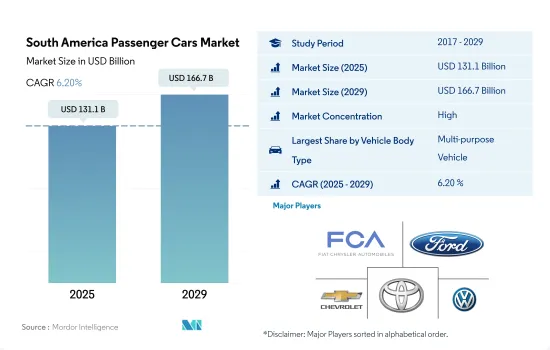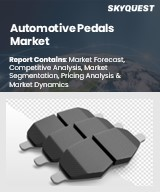
|
시장보고서
상품코드
1693628
남미의 승용차 시장 : 시장 점유율 분석, 산업 동향 및 통계, 성장 예측(2025-2030년)South America Passenger Cars - Market Share Analysis, Industry Trends & Statistics, Growth Forecasts (2025 - 2030) |
||||||
남미의 승용차 시장 규모는 2025년에 1,311억 달러로 추정되고, 2029년에는 1,667억 달러에 이를 것으로 예측되며, 예측 기간(2025-2029년)의 CAGR은 6.20%를 나타낼 것으로 예측됩니다.

남미의 승용차 시장은 경제적 요인, 소비자 선호도, 보다 지속 가능한 교통 솔루션으로의 전환에 따라 큰 변화를 겪고 있습니다.
- 남미의 자동차 산업은 아시이평양 국가에 비해 낮은 자동차 보유율과 가처분 소득의 빠른 증가 등의 요인에 힘입어 상당한 성장세를 보이고 있습니다.
- 코로나19 팬데믹은 소비자 구매력에 영향을 미쳐 유가가 눈에 띄게 하락했고, 이에 따라 휘발유 비용도 감소했습니다. 이러한 유가 하락으로 인해 기존 내연기관(ICE) 차량의 가격이 더 저렴해질 수 있지만, 대부분의 차급에서 전체 소유 비용 측면에서는 여전히 전기차가 우위에 있습니다. 그러나 이러한 정도는 다양하여 잠재적으로 판매에 영향을 미칠 수 있습니다.
- 남미에서는 사탕수수에서 추출한 에탄올이 눈에 띄는 선택으로 떠오르면서 지속 가능한 연료 옵션으로 주목할 만한 변화가 일어나고 있습니다.
남미의 승용차 시장 동향
급증하는 수요와 정부 인센티브가 남미의 전기자동차 시장을 뒷받침
- 남미의 브라질과 아르헨티나와 같은 국가는 자동차 시장에서 상당한 잠재력을 보여줍니다. 남미 자동차 산업은 최근 몇 년 동안 괄목할 만한 성장세를 보이고 있습니다. 특히 승용차 부문에서 전기자동차(EV)에 대한 수요가 증가하고 있습니다. 이러한 급증은 인식 제고, 환경에 대한 관심 증가, 전기차 도입을 장려하는 정부 노력 등의 요인에 기인합니다.
- 다양한 시장을 보유한 남미는 전기자동차가 급증할 것으로 예상됩니다. 특히 브라질은 재생 에너지 발전에 중점을 두고 있고, 전기차 배터리 개발에 필수적인 니오븀과 리튬이 풍부하게 매장되어 있어 전기 버스로의 전환에 주목하고 있습니다. 상파울루는 2022년 12월 디젤 버스 구매를 금지하고 2024년까지 2,600대의 전기 버스를 배치할 계획을 발표하면서 이러한 방향으로의 중요한 움직임이 시작되었습니다.
- 남미 국가들의 정부 정책과 인센티브 프로그램은 남미 지역의 차량 전기화를 촉진하는 주요 동력이 될 것입니다.
남미의 승용차 산업 개요
남미의 승용차 시장은 상당히 통합되어 있으며 상위 5개 기업이 65.90%를 점유하고 있습니다. 이 시장의 주요 업체는 Fiat Chrysler Automobiles N.V, Ford Motor Company, GM Motor (Chevrolet), Toyota Motor Corporation Volkswagen AG (알파벳 순 정렬)입니다.
기타 혜택
- 엑셀 형식 시장 예측(ME) 시트
- 3개월의 애널리스트 지원
목차
제1장 주요 요약과 주요 조사 결과
제2장 보고서 제안
제3장 소개
- 조사의 전제조건과 시장 정의
- 조사 범위
- 조사 방법
제4장 주요 산업 동향
- 인구
- 1인당 GDP
- 차량 구매를 위한 소비자 지출(CVP)
- 인플레이션율
- 자동차 대출 금리
- 공유 차량 서비스
- 전기화의 영향
- EV 충전소
- 배터리 팩 가격
- Xev 신모델 발표
- 연료 가격
- OEM 생산 통계
- 규제 프레임워크
- 밸류체인과 유통채널 분석
제5장 시장 세분화
- 차량 구성
- 승용차
- 해치백
- 다목적 차량
- 세단
- SUV
- 승용차
- 추진 부문
- 하이브리드 자동차와 전기자동차
- 연료 카테고리별
- BEV
- FCEV
- HEV
- PHEV
- ICE
- 연료 카테고리별
- 디젤
- 가솔린
- LPG
- 하이브리드 자동차와 전기자동차
- 국가명
- 아르헨티나
- 브라질
제6장 경쟁 구도
- 주요 전략 동향
- 시장 점유율 분석
- 기업 상황
- 기업 프로파일
- Fiat Chrysler Automobiles NV
- Ford Motor Company
- GM Motor(Chevrolet)
- Hyundai Motor Corporation
- Kia Corporation
- Nissan Motor Co. Ltd.
- Renault do Brasil S/A
- Stellantis NV
- Toyota Motor Corporation
- Volkswagen AG
제7장 CEO에 대한 주요 전략적 질문
제8장 부록
- 세계 개요
- 개요
- Five Forces 분석 프레임워크
- 세계의 밸류체인 분석
- 시장 역학(DROs)
- 출처 및 참고문헌
- 도표 일람
- 주요 인사이트
- 데이터 팩
- 용어집
The South America Passenger Cars Market size is estimated at 131.1 billion USD in 2025, and is expected to reach 166.7 billion USD by 2029, growing at a CAGR of 6.20% during the forecast period (2025-2029).

The South American passenger cars market is undergoing significant changes driven by economic factors, consumer preferences, and a shift toward more sustainable transportation solutions
- The automotive industry in South America is poised for significant growth, driven by factors such as low car ownership rates and a faster rise in disposable incomes compared to Asia-Pacific countries. Notably, the demand for electric vehicles (EVs) in South America has been on the rise, fueled by concerns about emissions reduction and future energy needs. Brazil's surging demand for EVs is particularly noteworthy, attracting several foreign automakers to set up production facilities in the region.
- The COVID-19 pandemic impacted consumer purchasing power, leading to a notable drop in oil prices and subsequently reducing gasoline costs. While this decline in gas prices may make conventional internal combustion engine (ICE) vehicles more affordable, EVs still hold an advantage in terms of overall ownership costs across most vehicle classes. However, the extent of this advantage may vary, potentially influencing sales.
- South America has seen a notable shift toward sustainable fuel options, with ethanol derived from sugarcane emerging as a prominent choice. This biofuel boasts emissions up to 90% lower than gasoline or diesel equivalents. Brazil's increasing adoption of sustainable fuels has played a pivotal role in shaping the regional market. Another significant driver is the growing consumption of renewable energy in the automotive industry. As the industry emphasizes sustainability, the ongoing research into automotive electrification in South America holds promise. Given the region's attractiveness as an investment hub due to its robust market growth potential, there are significant opportunities for both financial gains and market enhancements.
South America Passenger Cars Market Trends
Surging demand and government incentives propel South America's electric vehicle market
- Countries like Brazil and Argentina in South America show significant potential in the automobile market. The South American vehicle industry has witnessed notable growth in recent years. Notably, the region has seen a rising demand for electric vehicles (EVs), especially in the passenger car segment. This surge can be attributed to factors like heightened awareness, growing environmental concerns, and governmental initiatives promoting EV adoption. In fact, EV sales in the region saw a notable increase, growing by 17.95% in 2022 compared to 2021.
- South America, with its diverse markets, is poised for a surge in electric vehicles. Brazil, in particular, is eyeing a shift toward electric buses, driven by its focus on renewable power generation and its abundant reserves of niobium and lithium, crucial for EV battery development. A significant move in this direction came in December 2022 when Sao Paulo banned diesel bus purchases and announced plans to deploy 2600 electric buses by 2024-end. Similar trends in other South American nations are expected to drive vehicle electrification from 2024 to 2030.
- Government policies and incentive programs across South American nations are set to be key drivers for vehicle electrification in the region. Tax benefits, for instance, are playing a pivotal role. Colombia's government, for instance, is leveraging incentives and subsidies with an ambitious target of putting 600,000 EVs on its roads by 2030, aiming to tackle carbon emissions. With similar initiatives anticipated in other South American countries, the sales of EVs are expected to witness a surge from 2024 to 2030.
South America Passenger Cars Industry Overview
The South America Passenger Cars Market is fairly consolidated, with the top five companies occupying 65.90%. The major players in this market are Fiat Chrysler Automobiles N.V, Ford Motor Company, GM Motor (Chevrolet), Toyota Motor Corporation and Volkswagen AG (sorted alphabetically).
Additional Benefits:
- The market estimate (ME) sheet in Excel format
- 3 months of analyst support
TABLE OF CONTENTS
1 EXECUTIVE SUMMARY & KEY FINDINGS
2 REPORT OFFERS
3 INTRODUCTION
- 3.1 Study Assumptions & Market Definition
- 3.2 Scope of the Study
- 3.3 Research Methodology
4 KEY INDUSTRY TRENDS
- 4.1 Population
- 4.2 GDP Per Capita
- 4.3 Consumer Spending For Vehicle Purchase (cvp)
- 4.4 Inflation
- 4.5 Interest Rate For Auto Loans
- 4.6 Shared Rides
- 4.7 Impact Of Electrification
- 4.8 EV Charging Station
- 4.9 Battery Pack Price
- 4.10 New Xev Models Announced
- 4.11 Used Car Sales
- 4.12 Fuel Price
- 4.13 Oem-wise Production Statistics
- 4.14 Regulatory Framework
- 4.15 Value Chain & Distribution Channel Analysis
5 MARKET SEGMENTATION (includes market size in Value in USD and Volume, Forecasts up to 2029 and analysis of growth prospects)
- 5.1 Vehicle Configuration
- 5.1.1 Passenger Cars
- 5.1.1.1 Hatchback
- 5.1.1.2 Multi-purpose Vehicle
- 5.1.1.3 Sedan
- 5.1.1.4 Sports Utility Vehicle
- 5.1.1 Passenger Cars
- 5.2 Propulsion Type
- 5.2.1 Hybrid and Electric Vehicles
- 5.2.1.1 By Fuel Category
- 5.2.1.1.1 BEV
- 5.2.1.1.2 FCEV
- 5.2.1.1.3 HEV
- 5.2.1.1.4 PHEV
- 5.2.2 ICE
- 5.2.2.1 By Fuel Category
- 5.2.2.1.1 Diesel
- 5.2.2.1.2 Gasoline
- 5.2.2.1.3 LPG
- 5.2.1 Hybrid and Electric Vehicles
- 5.3 Country
- 5.3.1 Argentina
- 5.3.2 Brazil
6 COMPETITIVE LANDSCAPE
- 6.1 Key Strategic Moves
- 6.2 Market Share Analysis
- 6.3 Company Landscape
- 6.4 Company Profiles
- 6.4.1 Fiat Chrysler Automobiles N.V
- 6.4.2 Ford Motor Company
- 6.4.3 GM Motor (Chevrolet)
- 6.4.4 Hyundai Motor Company
- 6.4.5 Kia Corporation
- 6.4.6 Nissan Motor Co. Ltd.
- 6.4.7 Renault do Brasil S/A
- 6.4.8 Stellantis N.V.
- 6.4.9 Toyota Motor Corporation
- 6.4.10 Volkswagen AG
7 KEY STRATEGIC QUESTIONS FOR VEHICLES CEOS
8 APPENDIX
- 8.1 Global Overview
- 8.1.1 Overview
- 8.1.2 Porter's Five Forces Framework
- 8.1.3 Global Value Chain Analysis
- 8.1.4 Market Dynamics (DROs)
- 8.2 Sources & References
- 8.3 List of Tables & Figures
- 8.4 Primary Insights
- 8.5 Data Pack
- 8.6 Glossary of Terms



















